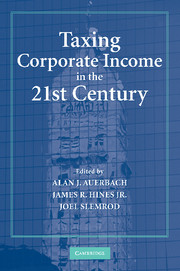Book contents
- Frontmatter
- Contents
- Contributors
- Preface
- 1 The Effects of Taxes on Market Responses to Dividend Announcements and Payments: What Can We Learn from the 2003 Dividend Tax Cut?
- Comments
- Comments
- 2 Dissecting Dividend Decisions: Some Clues about the Effects of Dividend Taxation from Recent UK Reforms
- Comments
- Comments
- 3 The 2003 Dividend Tax Cuts and the Value of the Firm: An Event Study
- Comments
- Comments
- 4 How Elastic Is the Corporate Income Tax Base?
- Comments
- Comments
- 5 An Empirical Examination of Corporate Tax Noncompliance
- Comments
- Comments
- 6 On the Extent, Growth, and Efficiency Consequences of State Business Tax Planning
- Comments
- Comments
- 7 Corporate Taxation and International Competition
- Comments
- Comments
- 8 The Changing Role of Auditors in Corporate Tax Planning
- Comments
- Comments
- 9 Taxation and the Evolution of Aggregate Corporate Ownership Concentration
- Comments
- Comments
- Index
- References
9 - Taxation and the Evolution of Aggregate Corporate Ownership Concentration
Published online by Cambridge University Press: 30 July 2009
- Frontmatter
- Contents
- Contributors
- Preface
- 1 The Effects of Taxes on Market Responses to Dividend Announcements and Payments: What Can We Learn from the 2003 Dividend Tax Cut?
- Comments
- Comments
- 2 Dissecting Dividend Decisions: Some Clues about the Effects of Dividend Taxation from Recent UK Reforms
- Comments
- Comments
- 3 The 2003 Dividend Tax Cuts and the Value of the Firm: An Event Study
- Comments
- Comments
- 4 How Elastic Is the Corporate Income Tax Base?
- Comments
- Comments
- 5 An Empirical Examination of Corporate Tax Noncompliance
- Comments
- Comments
- 6 On the Extent, Growth, and Efficiency Consequences of State Business Tax Planning
- Comments
- Comments
- 7 Corporate Taxation and International Competition
- Comments
- Comments
- 8 The Changing Role of Auditors in Corporate Tax Planning
- Comments
- Comments
- 9 Taxation and the Evolution of Aggregate Corporate Ownership Concentration
- Comments
- Comments
- Index
- References
Summary
We would like to thank Alan Auerbach, Steve Bank, Steve Bond, Bill Gale, Bill Gentry, Jim Hines, Emmanuel Saez, Richard Sansing, Gautam Tripathi, an anonymous referee, our discussants (Jeff Brown and Jeff Strnad) and participants at the Office of Tax Policy Research/Burch Center conference on “Taxing Corporate Income in the 21st Century” for valuable comments and suggestions on an earlier draft of this chapter. Mihir Desai acknowledges the financial support of the Division of Research of Harvard Business School.
Introduction
The extent to which corporate ownership is widely dispersed is an important dimension of an economy's corporate governance environment. The mechanisms by which diffuse owners police managers and the reasons why much of the world does not feature diffuse corporate ownership are major themes in the corporate governance literature. The comparative strand of this literature emphasizes legal origins as a critical determinant of the investor rights that facilitate ownership diffusion (e.g., La Porta et al., 1998). Subsequent efforts to trace the time-series patterns of governance and ownership concentration (e.g., Franks, Mayer, and Rossi, 2003; Rajan and Zingales, 2003) have questioned the singular role of legal investor protections, given the diffusion of ownership in the absence of legal protections at various times in the 20th century. The dispersion of corporate ownership across households is also closely related to questions surrounding stock market participation that have attracted considerable interest in the recent literature (e.g., Griffin, Nardari, and Stulz, 2004; Vissing-Jorgensen, 2002).
- Type
- Chapter
- Information
- Taxing Corporate Income in the 21st Century , pp. 345 - 383Publisher: Cambridge University PressPrint publication year: 2007
References
- 10
- Cited by

